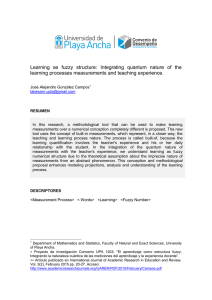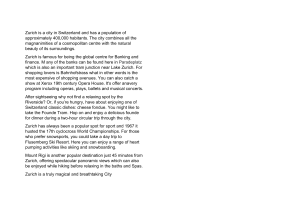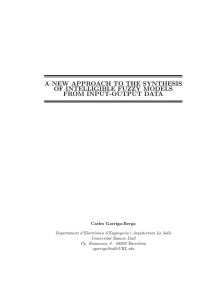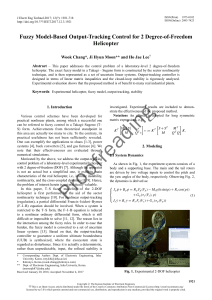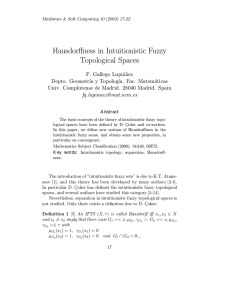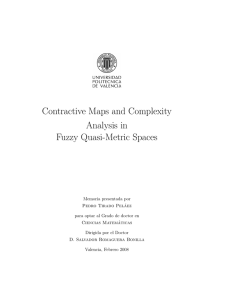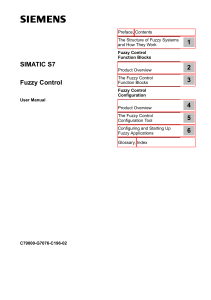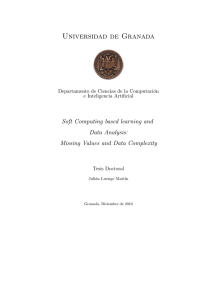Stochastic Modeling of a fuzzy index to determine the - IDAEA-CSIC
Anuncio
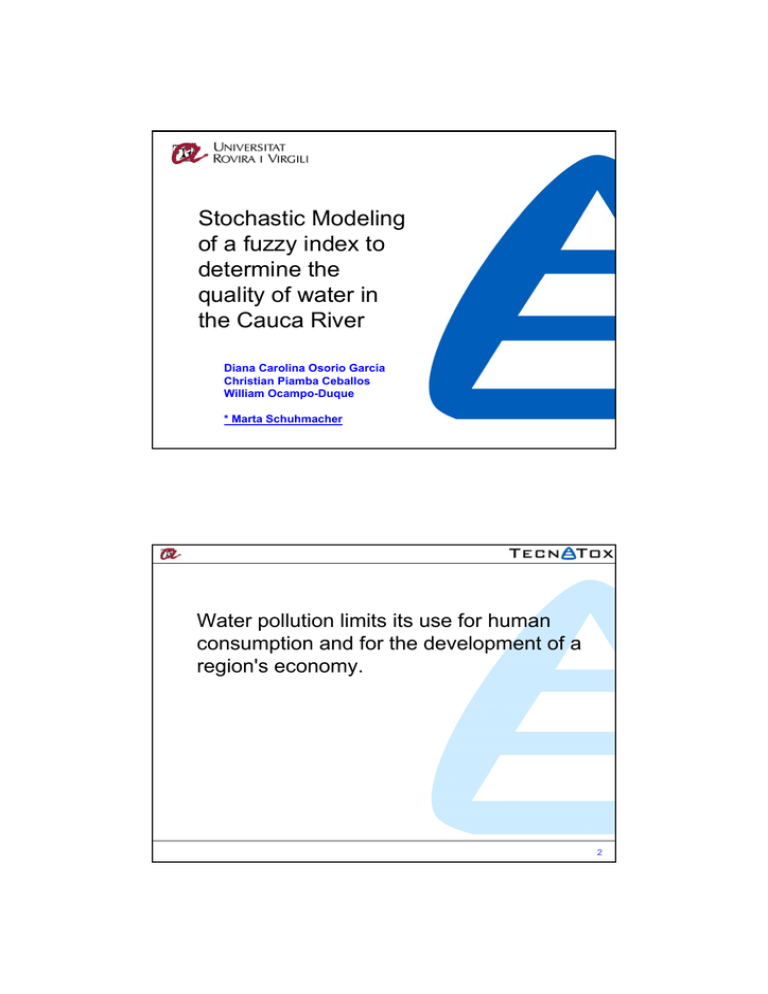
Stochastic Modeling of a fuzzy index to determine the quality of water in the Cauca River Diana Carolina Osorio García Christian Piamba Ceballos William Ocampo-Duque * Marta Schuhmacher Water pollution limits its use for human consumption and for the development of a region's economy. 2 3 Water requires an intelligent management as finite natural resource in harmony with the ecosystem (Water Framework Directive). Ecological assessment (EU Water Framework Directive) classification & presentation Water-quality status = Chemical status + Ecological status / potential Chemical status Bad status biotic elements abiotic elements Bad status Poor status Ecological status Good status Moderate status (differs moderately from type specific conditions) Good status (slight changes from type spec. conditions) target status yardstick High status (close to undisturbed conditions) max. ecol. reference potential Ecological status Do the biological quality meet reference conditions? yes no Do the biological quality deviate slightly from reference conditions? Do the physico-chemical conditions meet high status? yes no no yes yes Do the physico-chemical conditions: (a) ensure ecosystem functioning, and (b) meet the EQSs for specific pollutants? no Classify on the basis of the biological deviation from reference conditions Do the hydro-morphological conditions meet high status? Is the deviation moderate? yes no yes High status Good status Moderate status Poor status greater Is the deviation major? yes greater Bad status • The integration of water quality variables is essential in the processes of environmental decision making. • To that, it is essential to develop tools that they manage uncertainty and variability 4 General Objective To improve the environmental assessment with self-interpretable water quality indicators to control the subjectivity and uncertainty present in these complex environmental problems. 5 Specific Goal 1.- To developed a conceptual model to assess water quality in rivers from a perspective of environmental risk assessment, integrating a posibilistic model (Fuzzy) with a probabilistic model (Montse Carlo) to manage the uncertanty and the variabilty. 2.- To apply the model to a case study (Cauca river basin, Colombia) Cauca river Tramo Suarez- La Virginia 19 Monitoring stations Samples ●I Tram (Suarez- Puente Hormiguero) : 24 ●II Tram (Canal Navarro-Puente Mediacanoa) : 32 ●III Tram (Rio Frio-Puente la virginia) : 20 Yeasr of study : 2002, 2006, Parameters: pH, Oxígeno disuelto (OD), Coliformes fecales (CF), Demanda bioquímica de oxígeno (DBO5), Temperatura (T), Fosfatos totales (FT), Nitratos(N), Turbiedad (Tur), Sólidos totales (ST). 2009 Fuzzy Inference System Water quality indicator 1 Water quality indicator 2 … Water quality indicator 3 “ Inputs are crisp numbers limited to a range” Rule 1 Rule 2 Rule 3 Σ Water Status: 9 Excellent 9 Good 9 Average 9 Poor Rule 4 … “All rules are evaluated in parallel using fuzzy reasoning” “Results of rules are aggregated” “The result are crisp number” Fuzzy inference in risk assessment Membership functions Membership Functions 9 Inference rules Antecedent: If x is A and y is B Consequent: then z is C They simulate the expert knowledge x, y, z are “variables”; A, B, C are “qualifiers” Examples: If BOD5 is “low” then Water Quality is “Good” If BOD5 is “medium” then Water Quality is “Average” If BOD5 is “high” and DO is “low” then Water Quality is “Poor” 3.2 Mechanism of Fuzzy inference μ A∩B ( x) = min(μ A ( x), μ B ( x)) Mechanism of Fuzzy inference Results –Water Quality The Ebro basin Ocampo-Duque et al., Assessing water quality in rivers with fuzzy inference systems: a case study. Environment International, 2006 22 Simulation tool: Monte Carlo Method Method of generating random numbers Data Processing Exit OD Calidad del Agua FIS DBO Non-parametric Distributions 1. Histogram 2. Estimation by nuclei Kernel Gaussian Function Kernel Gaussiana Stochastic simulation Quantity of dates • Tram I : 24 • Tram II : 32 • Tram III : 20 Probability distribution 2006 TRAM I Coliform Temperat Turbied Sólidos Fosfatos es ura ad Totales Fecales Serie OD PH DBO Nitratos Distribució n: 5,7 6,81 1,78 0,4 Mejor Ajuste: Min Extreme Weibull Pareto Lognormal Gamma Logistic Anderson0,6918 Darling: 1,1661 0,8335 7,9438 1,5215 1,8256 0,4998 1,4446 0,2766 Valor - P: 0,000 --- 0,000 0,000 0,000 0,327 0,000 0,495 0,43 11201,33 21,13 172,37 0,03 186,98 Lognorm Logistic Lognormal al Results for Cauca river Tram II 2009 2006 2002 Tram I Results Tram III Results. Comparation with other index 2002 2006 2009 Tramo 1 Tramo 2 Tramo 3 Media Mala Mala Media Mala Mala Media Mala Mala 2002 2006 2009 Tramo 1 Tramo 2 Tramo 3 Aceptable Inadecuada Inadecuada Buena Buena Aceptable Buena Inadecuada Buena 2002 2006 2009 Tramo 1 Tramo 2 Regular Regular Tramo 3 Mala Regular Regular Mala Regular Regular Mala Conclusions • It should ensure the integration of different disciplines tools to understand and solve environmental problems. • Stochastic analysis is necessary, as these are similar to the behavior of surface sources, which are probabilistic and not deterministic . Thanks for your atention http://www.tecnatox.cat Acknowledgements: Spanish Agency for International Development cooperation (AECI) Thanks to the CVC for providing information for water quality parameters.
